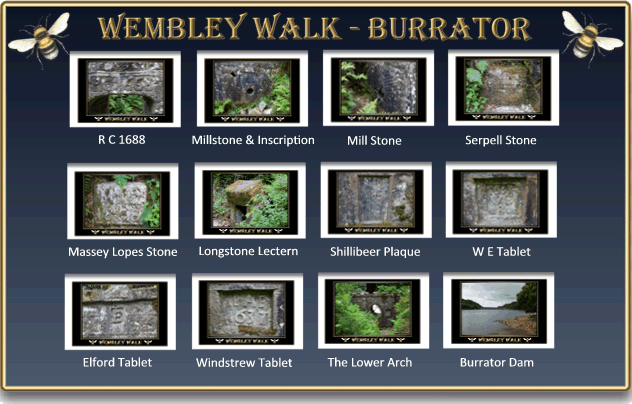
Wembley Walk, no it’s not a song akin to the ‘Lambeth Walk’ or anything to do with football although there is an association with the place called Wembley. It was here that on the 23rd of April 1924 the British Empire Exhibition was opened. In the same year the work of raising the Burrator Dams was underway, this was in order to satisfy the growing demand for water in Plymouth. In recognition of this fete of engineering a celebratory trip was organised to Wembley for many of the workers in order to visit the British Empire Exhibition. To commemorate this visit a pathway that formed part of the road which originally lead to the village of Sheepstor was named the ‘Wembley Walk’. I say ‘parts’ because much of the old road was submerged under the waters of the reservoir.
On a recent walk around Burrator Reservoir we (Rhys and myself) took the opportunity to visit Wembley Walk in order to take some photographs for this page. Having never been there before I just assumed that one simply strolled down through it. This was not the case, in normal circumstances Wembley Walk is not accessible to the public due to health and safety concerns. It was only through the kindness of Emily at the Discovery Centre that we were granted permission to go there – once gain, thank-you Emily for your assistance.
Wembley Walk is entered by a low, archway in which are embedded several granite artefacts, over the arch is a stone with what seems to be the initials ‘R C 1688‘. This feature made up part of the doorway from the old Roundy Farm which in 1688 was owned by Richard Crimes. In the bottom right-hand corner is an old millstones with the inscription; “P C W W – MILLSTONES REMOVED FROM – OLD LONGSTONE MANOR HOUSE – DOORWAY FROM ROUNDY FARM – RE-ERECTED 1934 BY GEO. SHILLIBEER.” For more information on Longstone Manor visit the Legendary Dartmoor webpage – HERE. The other millstone lies at the bottom left-hand side of the archway along with and partially overgrown plaque which reads; “R C SERPELL – MAYOR – PLYMOUTH CORPORATION – WATER WORKS – JAMES INO???.” Having walked through the archway another inscribed stones lies immediately on the left-hand side, this one bears the initials; “M. L. 1858” and refers to Sir Massey Lopes a local landowner and Alderman of Plymouth.. A little way further down the path is a small pond beside which sits a heavily moss-grown granite artefact. There is a much older photograph of this sitting in the ‘Dartmoor Archive’ where it states the mystery object is in fact a lectern from Longstone Manor – see HERE. If this is indeed the case, would this suggest that at some time a small chapel existed somewhere at Longstone Manor? If not a chapel then some kind of place for worship or else why would anyone need such a large and heavy lectern?
The path then meanders down towards the reservoir and another archway which again has several inscripted stones embedded in it, these all came from Longstone Manor. The testament to this is a large plaque which is located just to the right of the archway. This reads; “P. C. W. W. (the two Ws are missing) – DOORWAY AND – TABLETS REMOVED – FROM OLD – LONGSTONE MANOR – HOUSE – RE-ERECTED 1928 – BY – GEO. SHILLIBEER.” Immediately above this is a small tablet inscribed; “1633 – W. E. – ?8?.”, this refers to Walter Elford who rebuilt Longstone Manor around about this date. Above the arch and centrally placed is a simple tablet inscribed with an “E” for Elford. To the right of the arch is another tablet, this carries the letters; “I (J) E A E – 1637.” and relates to John and Anna Elford and supposedly was taken from the windstrew at Longstone Manor. There is another plaque under this tablet but it is virtually buried by the bank and I don’t think Emily would have been too happy if we unearthed it.
This lower arch then leads onto the edge of Burrator reservoir and affords some splendid vistas of the dam, Longstone headland and beyond.

I think one can safely say that nowhere on Dartmoor (apart from museums and the like) can one find so much history and heritage in such a small area. The various artefacts that live in Wembley Walk have deep associations with the past and in all reality thanks must go to George Shillibeer for having the forethought to save them. Without his actions all of these irreplaceable items would be lying at the bottom of the reservoir.
 Legendary Dartmoor The many aspects past and present of Dartmoor
Legendary Dartmoor The many aspects past and present of Dartmoor
